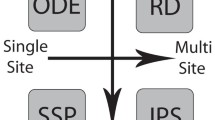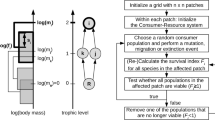Abstract
Persistence of ecological systems under climate change depends on how fast the environment is changing and on how species respond to that change. The rate of environmental change is a key factor affecting the responses. Adaptation, migration to more favorable habitats, and extinction are fundamental responses that species exhibit to climate change, but extinction is the most extreme one when species are unable to keep pace with climate change. The dynamics of extinction has long been addressed by theories of stochasticity, alternate states, and tipping points. But we are still lacking a non-equilibrium theory that explains how the rate of environmental change affects species responses, especially persistence. Here, we present spatial and non-spatial models of prey–predator interactions with Allee effect and show diverse responses characterized by different rates of environmental change. We show a community collapse to increasing rates of environmental change and also a stabilizing mechanism through unstable states of the non-spatial model. On the other hand, the spatially distributed community through dispersal exhibits multiple responses that include rescue effect, rate-driven extinction, and unexpected critical transitions and regime shifts. Furthermore, our results show a tracking of unstable states describing the role of unstable states in extinction debt and in maintaining spatial heterogeneity. Thus, this study reveals how the rate of environmental change reshapes community responses and predicts community persistence away from equilibrium states and also away from critical points.








Similar content being viewed by others
References
Adler PB, Drake JM (2008) Environmental variation, stochastic extinction, and competitive coexistence. The American Naturalist 172(5):E186–E195. https://doi.org/10.1086/591678
Amarasekare P (1998a) Allee effects in metapopulation dynamics. The American Naturalist 152 (2):298–302. https://doi.org/10.1086/286169
Amarasekare P (1998b) Interactions between local dynamics and dispersal: insights from single species models. Theor Popul Biol 53(1):44–59. https://doi.org/10.1006/tpbi.1997.1340
Amarasekare P (2008) Spatial dynamics of foodwebs. Annual Review of Ecology, Evolution, and Systematics 39(1):479–500. https://doi.org/10.1146/annurev.ecolsys.39.110707.173434
Antonovics J, McKane AJ, Newman TJ (2006) Spatiotemporal dynamics in marginal populations. The American Naturalist 167(1):16–27. https://doi.org/10.1086/498539
Arumugam R, Lutscher F, Guichard F (2020) Tracking unstable states: ecosystem dynamics in a changing world. (submitted)
Ashwin P, Wieczorek S, Vitolo R, Cox P (2012) Tipping points in open systems: bifurcation, noise-induced and rate-dependent examples in the climate system. Philosophical Transactions: Mathematical, Phys Eng Sci 370(1962):1166–1184
Bell G, Gonzalez A (2009) Evolutionary rescue can prevent extinction following environmental change. Ecol Lett 12(9):942–948. https://doi.org/10.1111/j.1461-0248.2009.01350.x
Berec L, Angulo E, Courchamp F (2007) Multiple Allee effects and population management. Trends in Ecology & Evolution 22(4):185–191
Berg MP, Kiers ET, Driessen G, Van Der Heijden M, Kooi BW, Kuenen F, Liefting M, Verhoef HA, Ellers J (2010) Adapt or disperse: understanding species persistence in a changing world. Glob Chang Biol 16(2):587–598. https://doi.org/10.1111/j.1365-2486.2009.02014.x
Biggs R, Carpenter SR, Brock WA (2009) Turning back from the brink: detecting an impending regime shift in time to avert it. Proceedings of the National Academy of Sciences 106(3):826–831. https://doi.org/10.1073/pnas.0811729106
Briggs CJ, Hoopes MF (2004) Stabilizing effects in spatial parasitoid–host and predator–prey models: a review. Theoretical Population Biology 65(3):299–315. https://doi.org/10.1016/j.tpb.2003.11.001
Carlson SM, Cunningham CJ, Westley PA (2014) Evolutionary rescue in a changing world. Trends in Ecology & Evolution 29(9):521–530. https://doi.org/10.1016/j.tree.2014.06.005
Chen IC, Hill JK, Ohlemüller R, Roy DB, Thomas CD (2011) Rapid range shifts of species associated with high levels of climate warming. Science 333(6045):1024–1026. https://doi.org/10.1126/science.1206432
Clements CF, Ozgul A (2016) Rate of forcing and the forecastability of critical transitions. Ecology and Evolution 6(21):7787–7793. https://doi.org/10.1002/ece3.2531
Courchamp F, Berec L, Gascoigne J (2008) Allee effects in ecology and conservation. Oxford University Press, Oxford
Cuddington KM, Yodzis P (1999) Black noise and population persistence. Proceedings of the Royal Society of London Series B:, Biological Sciences 266(1422):969–973. https://doi.org/10.1098/rspb.1999.0731
DeAngelis DL, Waterhouse JC (1987) Equilibrium and nonequilibrium concepts in ecological models. Ecol Monogr 57(1):1–21. https://doi.org/10.2307/1942636
Eriksson A, Elías-wolff F, Mehlig B, Manica A (2014) The emergence of the rescue effect from explicit within- and between-patch dynamics in a metapopulation. Proceedings of the Royal Society B:, Biological Sciences 281(1780):20133,127. https://doi.org/10.1098/rspb.2013.3127
Gotelli NJ (1991) Metapopulation models: the rescue effect, the propagule rain, and the core-satellite hypothesis. The American Naturalist 138(3):768–776. https://doi.org/10.1086/285249
Hanski I (1998) Metapopulation dynamics. Nature 396(6706):41–49. https://doi.org/10.1038/23876
Hastings A (2001) Transient dynamics and persistence of ecological systems. Ecol Lett 4(3):215–220. https://doi.org/10.1046/j.1461-0248.2001.00220.x
Hastings A, Abbott KC, Cuddington K, Francis T, Gellner G, Lai YC et al (2018) Transient phenomena in ecology. Science 361(6406):eaat6412. https://doi.org/10.1126/science.aat6412
Holt RD, Knight TM, Barfield M (2004) Allee effects, immigration, and the evolution of species’ niches. The American Naturalist 163(2):253–262. https://doi.org/10.1086/381408
Hufbauer RA, Szűcs M, Kasyon E, Youngberg C, Koontz MJ, Richards C, Tuff T, Melbourne BA (2015) Three types of rescue can avert extinction in a changing environment. Proceedings of the National Academy of Sciences 112(33):10 562:557–10. https://doi.org/10.1073/pnas.1504732112
Hughes TP, Linares C, Dakos V, van de Leemput IA, van Nes EH (2013) Living dangerously on borrowed time during slow, unrecognized regime shifts. Trends in Ecology & Evolution 28(3):149–155. https://doi.org/10.1016/j.tree.2012.08.022
Jackson ST, Sax DF (2010) Balancing biodiversity in a changing environment: extinction debt, immigration credit and species turnover. Trends in Ecology & Evolution 25(3):153–160
Keitt TH, Lewis MA, Holt RD (2001) Allee effects, invasion pinning, and species’ borders. The American Naturalist 157(2):203–216. https://doi.org/10.1086/318633
Kot M (2001) Elements of mathematical ecology. Cambridge University Press, Cambridge
Kramer AM, Dennis B, Liebhold AM, Drake JM (2009) The evidence for Allee effects. Popul Ecol 51(3):341–354
Kuussaari M, Bommarco R, Heikkinen RK, Helm A, Krauss J, Lindborg R, Öckinger E, Pärtel M, Pino J, Roda F et al (2009) Extinction debt: a challenge for biodiversity conservation. Trends in Ecology & Evolution 24(10):564–571. https://doi.org/10.1016/j.tree.2009.04.011
Lande R (1993) Risks of population extinction from demographic and environmental stochasticity and random catastrophes. The American Naturalist 142(6):911–927
Lenton TM (2011) Early warning of climate tipping points. Nat Clim Chang 1(4):201–209. https://doi.org/10.1038/nclimate1143
Melbourne BA, Hastings A (2008) Extinction risk depends strongly on factors contributing to stochasticity. Nature 454(7200):100–103. https://doi.org/10.1038/nature06922
Mori AS (2011) Ecosystem management based on natural disturbances: hierarchical context and non-equilibrium paradigm. J Appl Ecol 48(2):280–292. https://doi.org/10.1111/j.1365-2664.2010.01956.x
Morozov A, Abbott K, Cuddington K, Francis T, Gellner G, Hastings A, Lai YC, Petrovskii S, Scranton K, Zeeman ML (2019) Long transients in ecology: theory and applications. Physics of Life Reviews https://doi.org/10.1016/j.plrev.2019.09.004
O’Keeffe PE, Wieczorek S (eds.) (2019) Tipping phenomena and points of no return in ecosystems: beyond classical bifurcations. arXiv:190201796
Ovaskainen O, Meerson B (2010) Stochastic models of population extinction. Trends in Ecology & Evolution 25(11):643–652. https://doi.org/10.1016/j.tree.2010.07.009
Parmesan C (2006) Ecological and evolutionary responses to recent climate change. Annual Review of Ecology, Evolution, and Systematics 37(1):637–669. https://doi.org/10.1146/annurev.ecolsys.37.091305.110100
Phillips JD (2004) Divergence, sensitivity, and nonequilibrium in ecosystems. Geogr Anal 36 (4):369–383. https://doi.org/10.1111/j.1538-4632.2004.tb01142.x
Post E (2013) Ecology of climate change: the importance of biotic interactions monographs in population biology. Princeton University Press, Princeton
Pöyry J, Luoto M, Heikkinen RK, Kuussaari M, Saarinen K (2009) Species traits explain recent range shifts of Finnish butterflies. Glob Chang Biol 15(3):732–743. https://doi.org/10.1111/j.1365-2486.2008.01789.x
Reed TE, Schindler DE, Waples RS (2011) Interacting effects of phenotypic plasticity and evolution on population persistence in a changing climate. Conserv Biol 25(1):56–63. https://doi.org/10.1111/j.1523-1739.2010.01552.x
Rietkerk M, Dekker SC, de Ruiter PC, van de Koppel J (2004) Self-organized patchiness and catastrophic shifts in ecosystems. Science 305(5692):1926–1929. https://doi.org/10.1126/science.1101867
Scheffer M (2009) Critical transitions in nature and society. Princeton Studies in Complexity, Princeton University Press, Princeton
Scheffer M, Carpenter S, Foley JA, Folke C, Walker B (2001) Catastrophic shifts in ecosystems. Nature 413(6856):591–596. https://doi.org/10.1038/35098000
Scheffer M, Bascompte J, Brock WA, Brovkin V, Carpenter SR, Dakos V et al (2009) Early-warning signals for critical transitions. Nature 461(7260):53–59. https://doi.org/10.1038/nature08227
Scheffer M, Carpenter SR, Lenton TM, Bascompte J, Brock W, Dakos V et al (2012) Anticipating critical transitions. Science 338(6105):344–348. https://doi.org/10.1126/science.1225244
Siteur K, Eppinga MB, Doelman A, Siero E, Rietkerk M (2016) Ecosystems off track: rate-induced critical transitions in ecological models. Oikos 125(12):1689–1699. https://doi.org/10.1111/oik.03112
Stephens PA, Sutherland WJ (1999) Consequences of the Allee effect for behaviour, ecology and conservation. Trends in Ecology & Evolution 14(10):401–405
Tilman D, May RM, Lehman CL, Nowak MA (1994) Habitat destruction and the extinction debt. Nature 371(6492):65–66. https://doi.org/10.1038/371065a0
Walther G, Post E, Convey P, Menzel A, Parmesan C, Beebee TJC et al (2002) Ecological responses to recent climate change. Nature 416(6879):389–395. https://doi.org/10.1038/416389a
Acknowledgments
We thank the reviewers for the valuable suggestions.
Funding
RA received partial funding from the Centre for Applied Mathematics in Bioscience and Medicine (CAMBAM) to the postdoctoral research. FG received funding from the Natural Sciences and Engineering Research Council of Canada for funding through the Discovery Grant program (RGPIN-2017-04266) and Discovery Accelerator Supplement (RGPAS-2017-507832). FL received funding from the Natural Sciences and Engineering Research Council of Canada for funding through the Discovery Grant program (RGPIN-2016-04795) and for a Discovery Accelerator Supplement (RGPAS-2016-492872).
Author information
Authors and Affiliations
Corresponding author
Electronic supplementary material
Below is the link to the electronic supplementary material.
Rights and permissions
About this article
Cite this article
Arumugam, R., Guichard, F. & Lutscher, F. Persistence and extinction dynamics driven by the rate of environmental change in a predator–prey metacommunity. Theor Ecol 13, 629–643 (2020). https://doi.org/10.1007/s12080-020-00473-8
Received:
Accepted:
Published:
Issue Date:
DOI: https://doi.org/10.1007/s12080-020-00473-8




